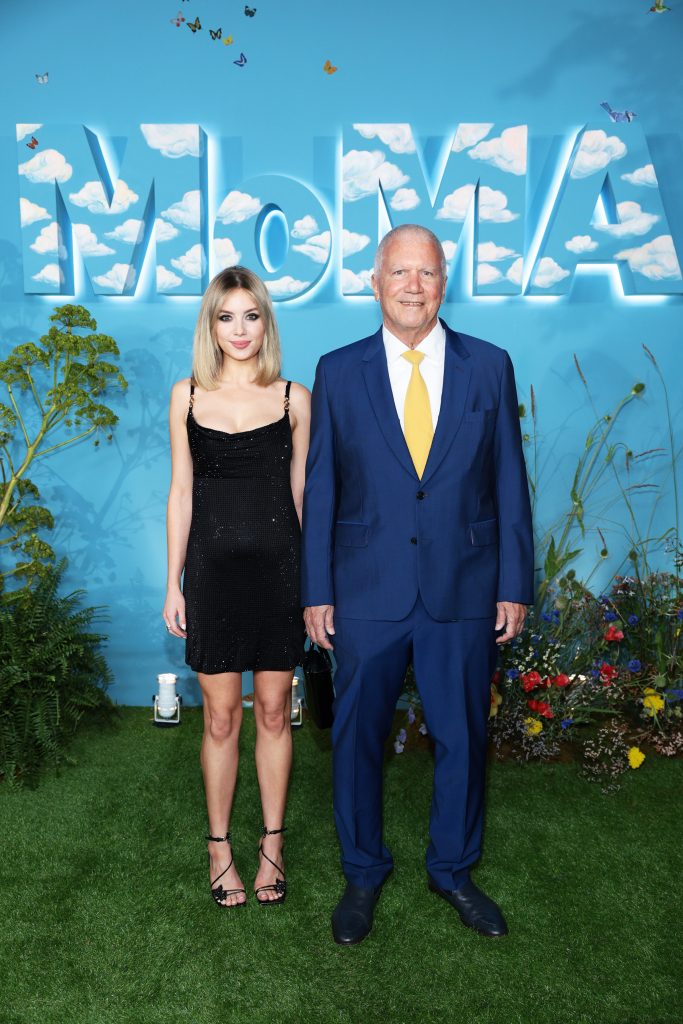Wet Paint
Larry Gagosian and Anna Weyant Call It Quits, Two Dealers Talk N.Y. vs. L.A., and More Juicy Art World Gossip
Plus, which rapper is collaborating with Alex Da Corte for their new album? Which New York museum director suddenly stepped down?

Plus, which rapper is collaborating with Alex Da Corte for their new album? Which New York museum director suddenly stepped down?

Annie Armstrong

Every week, Artnet News brings you Wet Paint, a gossip column of original scoops. If you have a tip, email Annie Armstrong at [email protected].
For the past two years, a sizable chunk of the art world has been obsessed with the May-December relationship between titan of industry Larry Gagosian, 78, and Anna Weyant, the painter-to-watch who is 50 years his junior. Along the way, we’ve witnessed one of the most remarkable (and exploited) market trajectories of the present era, a nasty and misogynistic pregnancy rumor (hear Weyant’s heart-rending perspective on Eileen Kelly’s podcast Going Mental here), a snapshot of their dynamic in Patrick Radden Keefe’s blockbuster New Yorker profile of the dealer, and periodic rumors that the two had broken up.
Their relationship has lasted about as long as my tenure writing Wet Paint, which is why it rattles me to report that I have it on good authority that the two have ended their romantic relationship.
Wet Paint reached out to both parties and did not receive word back. But several in-the-know sources independently tipped off your dear scribe off to the news.
This has been much more than just a romantic relationship, of course. Gagosian has been representing the artist and hosted two solo shows of her moody figurative paintings. The most recent closed last month in Paris.
While Weyant’s auction prices may have cooled off a bit since they hit seven figures (her record is $1.62 million, according to the Artnet Price Database), her works still regularly sell in the mid six figures. Two years before they met, when Gagosian was just collecting her work, Weyant’s drawings were selling for $400 (on a picnic blanket) via the scrappy, taste-making Manhattan gallery 56 Henry.
Within those two years, Weyant’s star began to soar, and she picked up representation from what was then known as Blum & Poe (now Blum). But that arrangement ended acrimoniously, with Tim Blum selling her Falling Woman (2020) at auction (where it set her record), after buying it a year prior for $15,000, and the artist joining Gagosian’s lineup.
On that note, there is no indication whatsoever that the breakup will impact Weyant’s relationship with the gallery, and according to sources, Weyant was seated and smiling at Gagosian’s dinner with Dior in Paris to celebrate Richard Avedon earlier this week. Her name remains firmly on the gallery’s online roster.
I’d like to propose a toast to a future for Weyant in which her artwork is discussed without mention of her personal life, while acknowledging that this column has not helped that initiative. Onwards.

New York and Los Angeles composite made using photos by Gary Hershorn and Mario Tama via Getty Images
The cross-pollination between the New York art world and the Los Angeles art world has been intense in recent years, with stalwarts like Marian Goodman, David Zwirner, and Pace heading west and standbys like David Kordansky, Nicodim, and Paul Soto coming east. More dealers are continuing to join the action.
The Santa Monica-raised Pietro Alexander, who runs Spy Projects in L.A. with his partners Gabriella Rothbart and Sasha Filimonov, plans to test the waters in New York this spring, opening a group show at his uncle Brooke Alexander‘s former gallery in SoHo (Alexander’s father is the late Light and Space legend Peter Alexander). Meanwhile, Emma Fernberger, the New York native who climbed the ranks at Bortolami in New York, is opening her own space in Hollywood this week with a one-person outing by painter Nicole Wittenberg.
How does it feel to set up shop on the other side of the U.S.? What are the competitive advantages of each place? I spoke with Alexander (by phone) and Fernberger (in person) to get a sense of the state of play. At a moment when the mid-tier of the market is precarious, their efforts suggest that a cross-country move can be a way for emerging dealers to reach a new level. Dealers: More leaps of faith like this, please! Their insights follow below.
Fernberger, New York to L.A.: Because New York is so expensive, it’s so hard for artists to live there and work there, and not just make itty-bitty knick-knacks. It’s a fucking challenge! I think it makes for a pretty homogenous place.
Alexander, L.A. to New York: I’ve heard that L.A. galleries can’t cut it in New York because it’s too expensive and there are are already too many good and successful galleries. This place attracts me, but what attracts me most about it is the concentration [of galleries] and the difference in geography. Those are the only fundamental differences in my eyes. To have a gallery here is to be close to the mechanical and organic parts of the moving organism of this city. In L.A., things are more isolated. Sometimes it feels like we’re on an island, even though we’re only a mile away from another gallery.
Fernberger: There’s a greater sense of ease and affordability [in Los Angeles] that keeps the culture really vibrant. It feels really community oriented… not in a Kumbaya way.
Alexander: I firmly believe that L.A. is the city that is on the up. And it’s not just because real estate is cheaper—if that was true, would galleries and artists move to Montana or Iowa? I don’t know. But they don’t because there’s infrastructure in L.A., there’s community, and there are institutions.
Alexander: New York has 100 years on L.A. as being a place for art, artists, and collectors. But New York only has that longer art history because it is on the East Coast and closer to Europe.
Fernberger: New York is still the center of the art world. That’s the power of New York. Every serious collector, if they don’t live in New York, then they travel to New York at least once a year. L.A. used to be a one-industry town, but that’s changing. There were a lot of migration patterns that happened during the pandemic, and L.A. is the beneficiary of that. Because of that, it’s become a bit more cosmopolitan.
Alexander: There’s absolutely no cultural superiority or creative energy that is more inherent to New York over L.A.—that’s bullshit. It’s a gross, rat-infested, busy monster! Admittedly, suffering does invoke incredible art, just look at Russian literature. But the other thing that makes art, and that makes art in the zeitgeist in America, is a concentration of people and money.
Fernberger: The market is just so saturated for galleries in New York. It’s a little harder to make a splash there. The advantage [of L.A.] is: bigger fish, smaller pond. And there’s proximity to L.A. artists who [remain unrepresented]. If I can give some of those people a show, and that show gets noticed by people in New York, then I’m doing my job. There are a lot of artists in New York that haven’t ever had an opportunity to show in L.A., and I get to provide that. This is Nicole’s first show in L.A.. And she’s shown a lot!
Alexander: I wouldn’t say I ride for L.A., but I just don’t think there’s fundamentally a difference anymore. The internet and the efficiency of digital communication have made it so that regional distinctions are much less pronounced.
Fernberger: People like to make this dichotomy of New York versus L.A., but so many people are New York and L.A. It’s a lot of the same people in constant dialogue.
Alexander: There are so many intriguing and enticing things about the New York art world because of its institutional qualities. I truly believe that to be successful, you have to in some way confront the powers that be, and you can’t shy away from the monoliths that are in your industry. You have to try to wrestle with them. New York, as an art scene, is ripe for L.A. gallerists to come in and disrupt it.
I don’t think so. https://t.co/WYawnzvjTm
— amy taubin (@AmyOrNot) January 18, 2024
Heartwarming story of the week: The internet managed to track down Amy Taubin‘s 1964 “Screen Test” by Andy Warhol after the 85-year-old film critic tweeted that it was not available online. It was the first time she had seen it since director David Cronenberg included it in a show he curated in the early aughts… Vittoria Calabrese has stepped down as executive director at Magazzino Italian Art, passing on the role to former director Filippo Fossati… The cult-y downtown New York newsletter Perfectly Imperfect has launched its own social media app… Lisson has taken on representation of sculptor Elaine Cameron-Weir, who previously showed in New York with the late-lamented JTT. (JTT’s former proprietor, Jasmin Tsou, joined Lisson late last year.)

Rejoice! Everyone’s favorite art/music collab has reunited, as artist Alex Da Corte created the delicious visuals for rapper Tierra Whack’s new album “World Wide Whack” *** Collectors Phil and Shelley Aarons and painters David Salle Emily Mae Smith were among the congregants at Houseman to fête Ross Bleckner over steak frites for his new show of paintings at Petzel‘s Chelsea headquarters. *** Is there a more fabulously blue-blooded event in New York than the opening of The Winter Show? The answer is no. The festivities this year included former Chanel COO Arie Kopelman, heiress Nicky Hilton, and socialite Polina Proshkina, among other well-heeled New Yorkers…